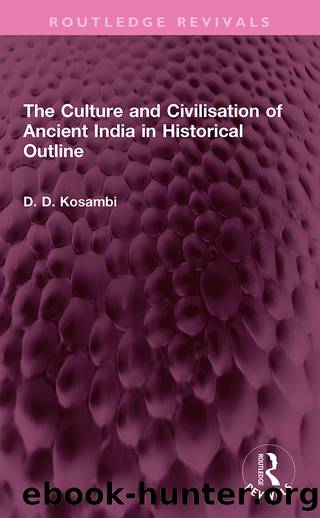The Culture and Civilisation of Ancient India in HIstorical Outline by D D Kosambi

Author:D D Kosambi
Language: eng
Format: epub
Publisher: Taylor and Francis
Published: 1965-06-15T00:00:00+00:00
CHAPTER SIXState and Religion in Greater Magadha
DOI: 10.4324/9781003321385-6
6.1. Completion of the Magadhan Conquest
THE fifth and fourth centuries B.C. are known to Indian archaeologists as the high age of NBP, the northern black polished ware. This describes an excellent grade of pottery first made as trade ceramics (presumably for wine and oils) about the sixth century; it went out of fashion a century or two before the beginning of the Christian era. No literature, records, or clearly dated inscriptions of these two centuries survive, but a firm historical date is supplied for the first time by Alexanderâs invasion of the PanjÄb in 327 B.C. The raid, which left no lasting effects upon Indian life, culture, or history, also provides an indispensable frame of reference through reports of the Indian scene as it appeared to the Greeks. It has always to be remembered that India was an exotic, even a fantastic land to Greek observers, as to most foreigners. There were extraordinary and incredible beasts like the elephant which could nevertheless be tamed. Wool grew on trees (cotton). Indian reeds were gigantic (bamboos), and the country produced a white crystal that tasted sweeter than honeyâsugar. Rivers of fabulous size (even when compared to the Nile), swift current, unexplored length, and unplumbable depths impressed those who lived by what Indians would call rivulets. The land miraculously yielded two or three bumper crops a year with minimum toil, where Greeks broke their backs to reap one harvest out of stony hillsides. It was baffling to see the Indians manage so well with no chattel slavery, an institution without which the noblest Greek philosophers such as Plato could not even imagine a viable city-state. The ultimate contrast with the chicanery and endless litigation of Greek civic life was the remarkable Indian ability to honour in full an agreement concluded by mere word of mouth, in the absence of any written, signed, and witnessed contract; says Arrian, âBut indeed, no Indian is ever known to lieâ! All this has to be allowed for in the interpretation of the record, particularly when a philosopher like Diodorus Siculus, looking for examples from which to construct an ideal society, misinterprets the words of a Greek traveller. Normally sceptical Greeks could believe almost anything of India.
The region to the west of the Indus had been the twentieth satrapy of the Persian Empire since its conquest by Darius I about 518 B.C. It seems to have been the most profitable of Achaemenid provinces. According to Herodotos, the annual tribute in gold dust was 360 talents, say close to nine tonsâan astounding treasure washed out of river sands on the upper Indus and placer-mined on the highlands of Tibet or KaÅmir. The wool and superb woollen cloth of the satrapy and its adjoining regions were famous even in India. Some local contingents fought in Xerxesâs army, so that the Greeks knew of India long before Alexander. The principal trade city of the province was PushkarÄvati, modern ChÄrsaddÄ, Peukelaotis to the Greeks. The
Download
This site does not store any files on its server. We only index and link to content provided by other sites. Please contact the content providers to delete copyright contents if any and email us, we'll remove relevant links or contents immediately.
Man-made Catastrophes and Risk Information Concealment by Dmitry Chernov & Didier Sornette(5924)
The Revenge of Geography: What the Map Tells Us About Coming Conflicts and the Battle Against Fate by Kaplan Robert D(4036)
Zero Waste Home by Bea Johnson(3781)
COSMOS by Carl Sagan(3559)
Good by S. Walden(3489)
In a Sunburned Country by Bill Bryson(3486)
The Fate of Rome: Climate, Disease, and the End of an Empire (The Princeton History of the Ancient World) by Kyle Harper(3006)
A Wilder Time by William E. Glassley(2818)
Camino Island by John Grisham(2763)
The Ogre by Doug Scott(2633)
Organic Mushroom Farming and Mycoremediation by Tradd Cotter(2631)
Human Dynamics Research in Smart and Connected Communities by Shih-Lung Shaw & Daniel Sui(2466)
Energy Myths and Realities by Vaclav Smil(2439)
The Traveler's Gift by Andy Andrews(2410)
9781803241661-PYTHON FOR ARCGIS PRO by Unknown(2324)
Inside the Middle East by Avi Melamed(2305)
Birds of New Guinea by Pratt Thane K.; Beehler Bruce M.; Anderton John C(2226)
A History of Warfare by John Keegan(2186)
And the Band Played On by Randy Shilts(2131)
